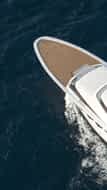In musical notation, the coda is used as a navigation marker. It is used when the exit from a repeated section is within that section rather than at the end. The instruction “To coda” indicates that, upon reaching that point during the final repetition, the performer is to jump immediately to the separate section headed with the coda symbol to provide a special ending for the final verse of music. This project was the first multihull (known for its large width) I ever worked on, which is why I found myself in front of an ocean of opportunities and free thought. First, for the exterior design of the SWATH, I chose to work with developable volumes, such as finding those that were best suited to the proposed hull shape. The white colour of both the exterior and interior brings a distinguished freshness, while reflecting the colour of the sky, especially at sunset. I wanted to gather all the technical functions in the heart of the project, which will make all the family spaces private, while still giving easy access for the crew to service each area. This central volume will be fully covered with mirrors on all decks. This helps to hide technical areas and give the illusion of bigger spaces and wide panoramas. As stated in the “Summary of the Client’s Requests”, the owner wanted a “private owner’s lounge” and would like appropriately sized tenders. As many of these tenders as possible should be housed in enclosed “garages”. I thus found it interesting to combine these two functions. For this reason, I placed glass panels between the private bar/lounge area and the tenders’ garage. My idea is to reveal the luxurious tenders with indirect lighting, showing off their fine design and treating them as decorative elements. Adding a kitchenette that suits the needs of the family to the “Summary of the Client’s Requests”, I designed a more user-friendly area. In addition to that, I designed a dining table (with a built-in BBQ) which has an extension to the open deck area and combines the different spaces.






Ready to enter the fascinating world of yacht design?
We welcome your call


